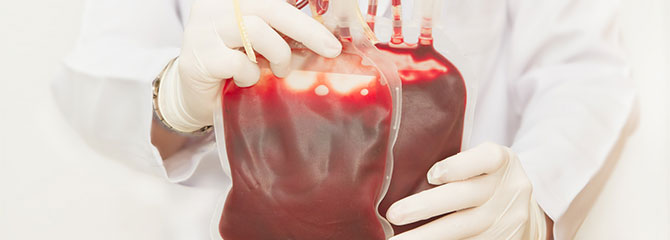Then and Now: How Things Have Changed

Since the 1920s, there have been many discoveries and advancements related to bleeding disorders.
Throughout history, many different bleeding disorders were recognized as illnesses, though not named. The cause of bleeding disorders remained a mystery. Assisted by science and technology, doctors would begin looking for the cause of hemophilia in the 20th century. The following timeline offers a glimpse into the significant advances and discoveries that have impacted those in the bleeding disorders community.
1920s
Von Willebrand disease (VWD), the most common hereditary bleeding disorder, was first recognized by the Finnish physician Erik von Willebrand. In a paper published on the disease in 1926, he outlined the ancestry of a Scandinavian family from the island of Åland. In that family, 23 of 66 members had bleeding symptoms.
1930s
Previously, doctors thought defective platelets were the likely cause of bleeding disorders. However, in 1937, doctors at Harvard University found they could correct the clotting problem by adding platelet-free plasma. They called the substance antihemophilic globulin, now called factor VIII (8).
Key Dates
1940s
In 1944, Dr. Alfredo Pavlosky from Buenos Aires, Argentina, found that when the blood from one person with hemophilia was mixed with the blood of another person with hemophilia, near-normal blood clotting sometimes occurred. Although not fully recognized at the time, this was due to the normal level of factor VIII (8) in the plasma of patients with hemophilia B correcting the defect in those with hemophilia A and vice versa. Pavlosky’s observation led to the eventual recognition of hemophilia A and hemophilia B as two distinct diseases.
By the end of the decade people with hemophilia had a life expectancy of less than 30 years. At that time, treatment was limited to icing joints where internal bleeding occurred and painful transfusions of whole blood.
Key Dates
1950s
In the 1950s and early 1960s, hemophilia and other bleeding problems were still being treated with whole blood or fresh plasma. Unfortunately, not enough factor VIII (8) or IX (9) proteins were in these treatments to stop serious internal bleeding. Many people with severe hemophilia, and some with mild or moderate forms, were still likely to die in childhood or early adulthood. The most common causes of death were bleeding in vital organs, especially the brain, and excessive bleeding after minor surgery or trauma. Those who survived were often crippled by the long-term painful effects of repeated hemorrhages into joints.
Key Dates
1960s
By the mid-1960s, the clotting factors were identified and named. In 1965, Dr. Judith Graham Pool published a paper on cryoprecipitate. In a major breakthrough, she had discovered that the precipitate left from thawing plasma was rich in factor VIII (8), a component essential for blood clotting. The substance could be infused to control serious bleeding. As a result, people with hemophilia no longer needed to be given large amounts of plasma to get enough of the clotting factor they needed. Blood banks could now produce and store the component, making emergency surgery and elective procedures for hemophilia patients safer and more practical.
Key Dates
1970s
By the 1970s, freeze-dried powdered concentrates containing factor VIII (8) or IX (9) became available. Factor products revolutionized hemophilia care because they could be stored at home, making treatment easily accessible. People with hemophilia could now self-infuse factor products, drastically reducing the need for hospital visits. Work, travel, and other activities were now carried out with greater ease, giving individuals with hemophilia increased independence.
Key Dates
1980s
Although the hepatitis C virus (HCV) was already present—but unrecognized—in the blood supply, a new blood-borne disease emerged in the early 1980s. By mid-decade, it became clear that HIV could be transmitted through the use of blood and blood products, such as those used to treat hemophilia. In the United States, approximately half of the people with hemophilia eventually became infected with HIV and thousands died. The devastating impact of HIV on the hemophilia community reverberated well into the next decade.
Key Dates
1990s
Treatment for hemophilia and other bleeding disorders advanced in the 1990s. Factor products improved and became safer as strict screening methods were implemented and advanced methods of viral inactivation were used. In addition, synthetic factor products were manufactured using recombinant technologies. Additional synthetic drugs such as desmopressin acetate (DDAVP) were also introduced to treat mild to moderate hemophilia A and VWD.
By the mid 1990s, prophylactic therapy in children with hemophilia became more common. Since the advent of prophylaxis, children could look forward to a life of less pain, with lower risk of the orthopedic damage caused by frequent bleeding into the joints.
Key Dates
2000s
- Advances include a better understanding of the cause, detection, and elimination of inhibitors found in many hemophilia patients
- Children who start prophylaxis at a young age, and maintain their treatment, can look forward to fewer breakthrough bleeds and secondary complications
- Exercise and nutrition are recognized as playing important roles in the treatment of all hemophilia patients
- Several new technologies are being implemented to advance hemophilia treatment. These new technologies, once used to destroy viruses in blood, have been successful in virtually eliminating the risk of contracting HIV or hepatitis C from factor products
- FDA approves first recombinant factor products made without human or animal plasma derivatives
- FDA approves first acute bleeding episode treatment for factor I (1) deficiency (fibrinogen deficiency) (2009)
2010s
- FDA approves factor concentrate to treat factor XIII (13) deficiency (2011)
- FDA approves factor concentrate to treat factor X (10) deficiency (2015)
- FDA approves the first bispecific antibody treatment that is subcutaneous (injection under skin) product to treat factor VIII (8) deficiency for those with inhibitors (2017) and those without inhibitors (2018)
